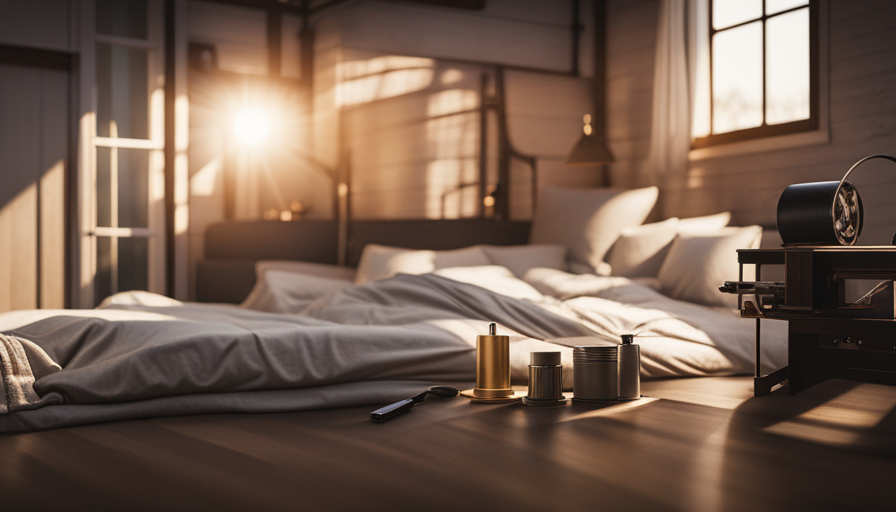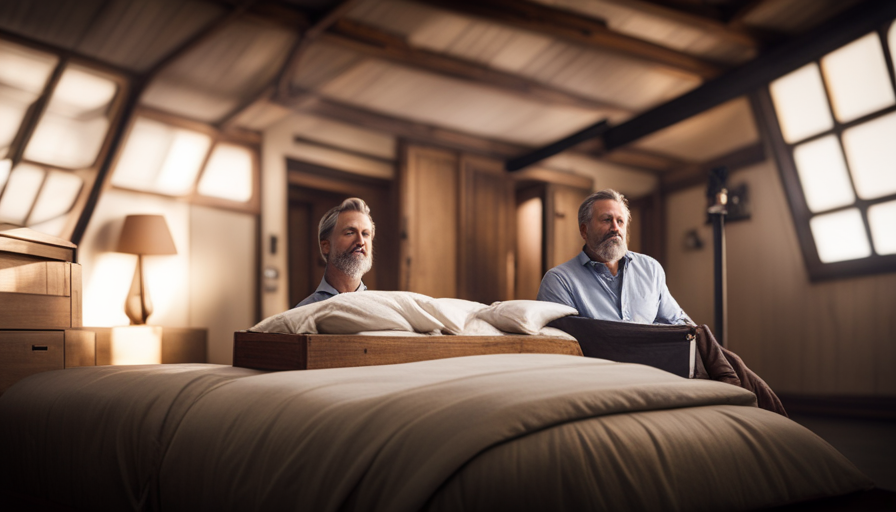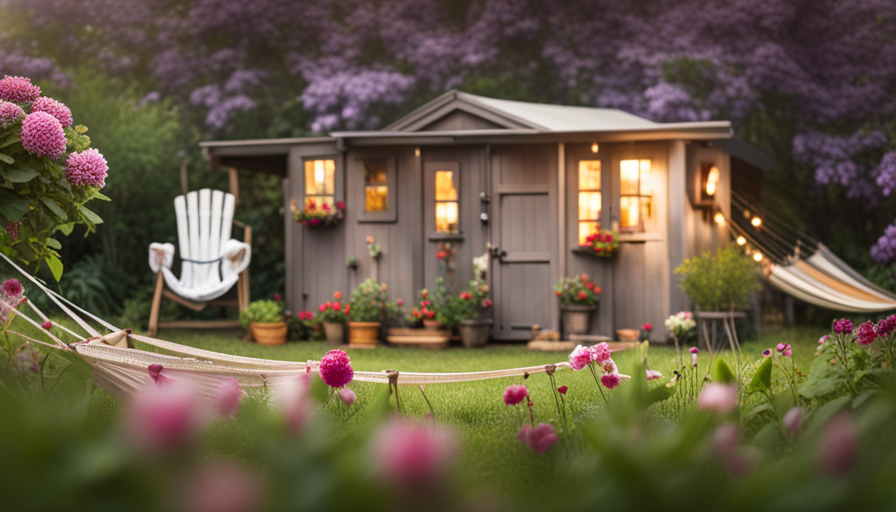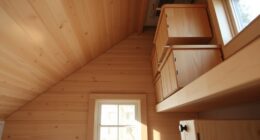As the old adage goes, good things come in small packages. This is particularly true in the world of tiny house living. But have you ever considered stepping it up a notch by living in a charming tiny house loft? These unique and imaginative living spaces are gaining popularity worldwide, and for good reason.
In this article, I’ll delve into all the details of how hot tiny house lofts are changing the way we live. From their unique design features to the benefits of living in one, choosing the right location, building and customizing, creating an outdoor living space, living in a community, maintaining and upgrading, and overcoming challenges, I’ll leave no stone unturned.
So, if you’re ready to dive into the world of hot tiny house lofts, let’s get started!
Key Takeaways
- Hot tiny house lofts are a popular and sustainable living option that promotes a simplified lifestyle and reduces environmental impact.
- They utilize reclaimed materials, renewable energy sources, and efficient space planning to minimize waste and decrease utility bills.
- Choosing the right location is crucial, considering utilities, zoning regulations, natural surroundings, and accessibility.
- Building and customizing a hot tiny house loft allows for personalization, adaptation to individual needs, and efficient utilization of every square inch of space.
Unique Design Features of Hot Tiny House Lofts
Get ready to be amazed by the unique design features that make hot tiny house lofts stand out! These small, yet stunning spaces are designed with a focus on sustainability and functionality.
One of the key design elements is the use of reclaimed materials. From the flooring to the furniture, everything is carefully chosen to minimize waste and reduce the environmental impact. Not only does this add a rustic charm to the space, but it also gives the loft a sense of history and character.
Another design feature that sets hot tiny house lofts apart is the emphasis on maximizing natural light. Large windows and skylights are strategically placed to flood the space with sunlight, creating a bright and airy atmosphere. This not only makes the loft feel more spacious, but it also helps to reduce the need for artificial lighting during the day, saving energy and lowering utility bills.
Living in a hot tiny house loft offers numerous benefits, from the freedom to travel to a simplified and minimalist lifestyle. The unique design features of reclaimed materials and maximizing natural light make these lofts both visually stunning and environmentally friendly.
So, if you’re ready to embrace a smaller, more sustainable way of living, step into the world of hot tiny house lofts and experience the beauty and functionality they have to offer.
Benefits of Living in a Hot Tiny House Loft
Living in a hot tiny house loft offers numerous benefits that align with my desire for a reduced environmental impact, lower cost of living, and simplified lifestyle.
By choosing to live in a small and energy-efficient space, I can significantly decrease my carbon footprint and contribute to a more sustainable future.
Additionally, the lower cost of utilities and maintenance in a tiny house loft allows me to save money and allocate my resources towards other priorities.
Finally, the simplicity of living in a small space promotes a decluttered and minimalistic lifestyle, allowing me to focus on what truly matters and avoid the stress of excess possessions.
Reduced Environmental Impact
By embracing sustainable design elements, tiny house lofts offer a cozy sanctuary while leaving a smaller carbon footprint. These eco-friendly homes are designed with reducing energy consumption in mind.
With their small size and efficient insulation, tiny house lofts require less energy to heat or cool compared to traditional homes. Additionally, sustainable building materials such as recycled wood, bamboo, and reclaimed materials are often used in the construction of these lofts. This further reduces the environmental impact by minimizing the use of new resources.
Furthermore, tiny house lofts often incorporate renewable energy sources like solar panels, allowing residents to generate their own power and reduce reliance on fossil fuels. By reducing energy consumption and utilizing sustainable materials, tiny house lofts are a responsible choice for environmentally-conscious individuals.
Transitioning into the next section, these eco-friendly homes also offer the advantage of a lower cost of living.
Lower Cost of Living
With a reduced cost of living, tiny house lofts provide an affordable and sustainable living option for those seeking a cozy and environmentally-friendly home. The minimalist living concept of tiny house lofts allows for financial savings in various aspects of daily life.
Firstly, the smaller size of these homes means lower construction and maintenance costs. Additionally, the reduced square footage leads to decreased utility bills, as heating, cooling, and lighting requirements are significantly reduced.
Moreover, the limited space encourages a simplified lifestyle, promoting mindful consumption and discouraging unnecessary purchases. This further contributes to financial savings by reducing expenses on material possessions and encouraging a focus on experiences rather than material goods.
Transitioning to the subsequent section about simplified lifestyle, it becomes clear that tiny house lofts offer not only financial advantages but also a more fulfilling way of living.
Simplified Lifestyle
Embracing a simpler way of life, the minimalist appeal of these cozy homes fosters a content and fulfilling lifestyle. By downsizing and focusing on the essentials, individuals can experience the benefits of minimalist living in a hot tiny house loft.
One of the main advantages is the reduced cost of living, as smaller spaces require less maintenance and lower utility bills. Additionally, the simplified lifestyle promotes a sense of freedom and clarity, allowing individuals to prioritize experiences over material possessions. With fewer belongings, there’s less clutter and more opportunity to focus on personal growth and relationships. This intentional living approach can lead to increased happiness and a greater sense of fulfillment.
Transitioning from the benefits of a simplified lifestyle, the next crucial step is choosing the right location for your hot tiny house loft.
Choosing the Right Location for Your Hot Tiny House Loft
When it comes to your hot tiny house loft, have you considered the perfect location to paint a picture of tranquility and beauty? Finding the right location for your tiny house is crucial to ensure a simplified lifestyle. Here are four key factors to consider when choosing the perfect spot for your hot tiny house loft:
-
Suitable utilities: Before settling on a location, make sure to research and confirm that you’ll have access to necessary utilities such as electricity, water, and sewage. It’s important to ensure that your hot tiny house loft is equipped with all the essential amenities.
-
Zoning regulations: Different areas have different zoning regulations that may impact your ability to build and live in a tiny house. Check with local authorities to understand the zoning laws in your desired location. Some areas may have restrictions on the size and placement of tiny houses, so it’s crucial to comply with these regulations to avoid any legal issues.
-
Natural surroundings: Consider the natural surroundings of the location. Do you prefer a wooded area, a coastal setting, or a mountain view? Think about the scenery that brings you joy and choose a location that aligns with your preferences.
-
Accessibility: Evaluate the accessibility of the location. Is it close to amenities such as grocery stores, healthcare facilities, and recreational activities? Ensure that the location provides convenience and easy access to essential services.
Choosing the right location for your hot tiny house loft is essential for creating a harmonious and fulfilling living environment. Once you’ve found the perfect spot, it’s time to move on to building and customizing your hot tiny house loft, where you can truly make it your own.
Building and Customizing Your Hot Tiny House Loft
After carefully selecting the perfect location for your hot tiny house loft, it’s time to dive into the exciting process of building and customizing your dream space.
One of the most appealing aspects of tiny houses is the ability to personalize and adapt the design to suit your needs and preferences. From layout to finishes, there are countless customizing options to consider.
When it comes to maximizing space in your hot tiny house loft, efficiency is key. Clever storage solutions like built-in shelves, hidden compartments, and multi-purpose furniture can make a significant difference. Additionally, incorporating space-saving features such as lofted beds, foldable tables, and wall-mounted appliances can help create a functional and open living area.
It’s important to carefully plan the layout and design of your hot tiny house loft to ensure every square inch is utilized efficiently. Consider factors like traffic flow, natural light, and the placement of key features such as the kitchen and bathroom. By thoughtfully customizing your space, you can create a cozy and inviting atmosphere that perfectly suits your lifestyle.
As we move forward, let’s explore the essential features for comfort and functionality in your hot tiny house loft.
Essential Features for Comfort and Functionality
Maximizing the potential of your cozy sanctuary involves incorporating essential features that will provide optimal comfort and seamless functionality. When it comes to designing your hot tiny house loft, choosing the right furniture and storage solutions is key. By carefully selecting pieces that are both compact and multi-functional, you can make the most of your limited space.
To help you envision the possibilities, here is a table showcasing some examples of furniture and storage options for your hot tiny house loft:
| Furniture | Storage Solutions | Lighting |
|---|---|---|
| Convertible sofa | Under-bed drawers | LED recessed |
| Foldable table | Wall-mounted | lighting |
| Murphy bed | shelves | Skylight |
| Ottoman with | Overhead storage | Natural light |
| hidden storage |
Choosing furniture that can serve multiple purposes, such as a convertible sofa or a foldable table, allows you to maximize the functionality of your space. Additionally, incorporating storage solutions like under-bed drawers or wall-mounted shelves helps keep your tiny house clutter-free and organized.
In the next section, I will share some valuable tips for downsizing and decluttering your hot tiny house loft, ensuring that you create a serene and harmonious living environment without sacrificing your comfort or functionality.
Tips for Downsizing and Decluttering
To create a serene and harmonious living environment, make downsizing and decluttering a priority. This will optimize your space and enhance your comfort and functionality. Here are some tips for organization and maximizing storage in your hot tiny house loft:
-
Utilize vertical space: Install shelves or wall-mounted organizers to make the most of your walls and free up valuable floor space. This’ll help keep your belongings organized and easily accessible.
-
Invest in multi-functional furniture: Look for furniture pieces that serve multiple purposes, such as a sofa bed or a coffee table with hidden storage compartments. This’ll help you maximize your storage options while still providing essential functionality.
-
Use storage containers and dividers: Keep your belongings organized by using storage containers and dividers. This’ll help you categorize items and prevent clutter from accumulating.
By implementing these tips for organization and maximizing storage, you can create a more efficient and enjoyable living space in your hot tiny house loft. With a clutter-free environment, you’ll have more room to relax and fully embrace the comfort and functionality of your home.
In the next section, we’ll explore how to create an outdoor living space for your hot tiny house loft, allowing you to extend your living area beyond the confines of your cozy interior.
Creating an Outdoor Living Space for Your Hot Tiny House Loft
After successfully downsizing and decluttering my hot tiny house loft, I was eager to create an outdoor living space that would complement the cozy interior. Incorporating outdoor decor and gardening ideas into the design would not only enhance the overall aesthetic of my tiny house, but also provide a peaceful retreat where I could relax and unwind.
To bring my vision to life, I decided to create a 2-column, 3-row table that would serve as a visual representation of my ideas. In the first column, I listed various outdoor decor options such as string lights, colorful cushions, and a small bistro table. These items would add a touch of charm and create a welcoming atmosphere in my outdoor space. In the second column, I brainstormed gardening ideas such as vertical planters, hanging baskets, and a miniature herb garden. These would not only beautify my outdoor space but also provide fresh herbs for cooking.
By incorporating these elements into my outdoor living space, I knew I would have a tranquil oasis right outside my tiny house. The combination of outdoor decor and gardening would create a seamless transition between the interior and exterior of my home, maximizing the overall living space. With my outdoor space complete, I was ready to explore the next step of living in a community of hot tiny house lofts.
Living in a Community of Hot Tiny House Lofts
Living in a community of hot tiny house lofts offers numerous benefits. One of the main advantages is the opportunity to enjoy a sense of camaraderie and support from like-minded individuals. In this close-knit community, shared resources and amenities are readily available, making it easier to live a sustainable and efficient lifestyle.
Building relationships within this community fosters a network of support. Here, individuals can rely on each other for advice, assistance, and a sense of belonging.
Benefits of Community Living
Imagine the joy and sense of belonging you’ll experience when you join a community living in a tiny house loft, where the benefits are endless. Living in a community provides numerous advantages, from fostering social connections to engaging in collaborative projects.
The following sub-lists highlight these benefits:
-
Social connections:
- Opportunities for building lifelong friendships and support networks.
- Regular community events and activities that encourage socializing and bonding.
- A sense of belonging and a shared purpose.
-
Collaborative projects:
- Collective problem-solving and brainstorming sessions.
- Pooling of resources and skills for shared projects.
- Learning from others and expanding knowledge through collaboration.
Being a part of such a community not only enhances your social life but also promotes personal growth and a sense of fulfillment. It sets the stage for the subsequent section about shared resources and amenities, where we explore the practical aspects of community living.
Shared Resources and Amenities
By sharing resources and amenities, community living in a tiny house loft becomes even more convenient and economical. In a community setting, residents can pool their resources to create a more sustainable and efficient living environment. Shared resources such as kitchen appliances, tools, and laundry facilities eliminate the need for each individual to own and maintain their own, saving both money and space. Additionally, community living allows for the sharing of amenities like communal gardens, fitness areas, and common spaces, providing residents with a wider range of options without the need for individual ownership. This not only reduces the environmental impact but also fosters a sense of cooperation and collaboration among neighbors. By sharing resources and amenities, community living in a tiny house loft promotes a more sustainable and connected lifestyle. In the next section, we will explore how this communal living also helps in building relationships and supportive networks.
Building Relationships and Supportive Networks
Through the metaphorical lens of a tapestry being woven together, the building of relationships and supportive networks within a community living setting creates a strong and interconnected fabric that supports and uplifts its residents.
In the context of hot tiny house lofts, building support and networking opportunities are crucial for a sustainable and fulfilling lifestyle. Living in such close proximity with others requires a sense of camaraderie and mutual assistance. By forming relationships with fellow residents, we can share resources, ideas, and experiences, fostering a sense of belonging and support.
Additionally, supportive networks provide a safety net for emergencies or unexpected challenges that may arise. Whether it’s lending a helping hand in maintaining our lofts or offering emotional support during tough times, these relationships cultivate a sense of community and enhance our overall living experience.
As we delve into the subsequent section about maintaining and upgrading our hot tiny house lofts, it becomes evident that these networks play a vital role in sharing knowledge and expertise, ensuring that we can continue to thrive in our compact living spaces.
Maintaining and Upgrading Your Hot Tiny House Loft
To keep your hot tiny house loft in top condition, you’ll need to regularly maintain and upgrade it. Here are some key steps to consider:
-
Upgrading insulation: One of the most effective ways to maintain a comfortable temperature in your hot tiny house loft is to upgrade its insulation. This can involve adding additional layers of insulation to the walls, floor, and ceiling. By improving the thermal efficiency of your loft, you can minimize heat loss during the colder months and reduce the need for excessive cooling during hot summer days.
-
Maximizing storage space: In a small living space like a hot tiny house loft, it’s crucial to make the most of every inch of available storage. Consider installing built-in shelves, cabinets, and drawers to optimize storage capacity. Utilize vertical space by incorporating tall bookcases or installing hanging racks for clothing and accessories. Additionally, choose multi-purpose furniture that offers hidden storage compartments, such as ottomans with lift-up lids or beds with built-in drawers.
-
Regular maintenance: Regularly inspect and maintain your hot tiny house loft to address any potential issues before they become major problems. This includes checking for leaks, cleaning and servicing HVAC systems, and ensuring that all appliances are in good working order. It’s also important to keep the loft clean and tidy to prevent the buildup of dust and debris.
By upgrading insulation and maximizing storage space, you can create a more comfortable and efficient living environment in your hot tiny house loft. This will allow you to overcome challenges and fully enjoy the hot tiny house loft lifestyle.
Overcoming Challenges and Enjoying the Hot Tiny House Loft Lifestyle
When it comes to living in a hot tiny house loft, there are definitely some challenges to overcome. Limited space and privacy can be a real issue, but with some creative thinking, it can be managed.
Finding solutions for hosting guests can also be tricky, but again, thinking outside the box can lead to some great ideas.
Ultimately, the freedom and flexibility of tiny living make all the challenges worth it.
Dealing with Limited Space and Privacy
Despite the cramped quarters, living in a tiny house loft feels like snuggling inside a cozy, magical hideaway. Maximizing storage and creating multipurpose spaces are essential to making the most of the limited space.
Every nook and cranny must be utilized efficiently. From under-bed storage compartments and built-in shelving units to collapsible furniture and hidden storage solutions, every inch counts. By cleverly integrating storage options into the design, I’ve been able to keep my tiny home organized and clutter-free.
Additionally, creating multipurpose spaces is crucial in maximizing functionality. For example, my dining table doubles as a workspace, and my couch transforms into a guest bed.
Despite the lack of privacy in a tiny house loft, finding creative solutions for hosting guests is still possible. The key is to prioritize comfort and adaptability, ensuring that guests feel welcomed and comfortable without sacrificing the functionality of the space.
Finding Creative Solutions for Hosting Guests
Now that we have explored how to deal with limited space and privacy in tiny house lofts, let’s move on to finding creative solutions for hosting guests. One of the challenges of living in a tiny house is accommodating visitors while maximizing the limited space available. However, with some thoughtful planning and innovative ideas, it is possible to create a comfortable and inviting space for guests.
One option is to invest in multifunctional furniture that can serve multiple purposes, such as a sofa that can be converted into a guest bed or a dining table that can be extended to accommodate more people. Additionally, utilizing vertical space through loft beds or bunk beds can help maximize sleeping areas without taking up precious floor space.
To give you a better understanding of these creative solutions for hosting guests, take a look at the table below:
| Creative Solutions for Hosting Guests |
|---|
| Multifunctional furniture |
| Vertical space utilization |
| Foldable and collapsible furniture |
| Privacy screens and curtains |
By implementing these solutions, you can ensure that your guests feel welcomed and comfortable during their stay in your tiny house. Now, let’s move on to the next section about embracing the freedom and flexibility of tiny living.
Embracing the Freedom and Flexibility of Tiny Living
To fully embrace the freedom and flexibility of living in a compact dwelling, you can enrich your lifestyle by embracing the endless possibilities that come with maximizing space and minimizing clutter.
The tiny house movement has gained traction in recent years, with many individuals choosing to downsize and simplify their lives. While living in a tiny house does come with its limitations, such as limited storage space and the need for creative solutions, it also offers a sense of freedom that larger homes can’t provide.
The freedom to pick up and move whenever you desire, the freedom to live more sustainably, and the freedom to focus on experiences rather than material possessions. By embracing the tiny house lifestyle, you can truly embrace the freedom and flexibility that comes with it.
Frequently Asked Questions
What are some common challenges faced by people living in hot tiny house lofts?
Living in hot tiny house lofts presents unique challenges. It’s like being trapped in a sizzling desert without a shade. The scorching heat can be unbearable, making it essential to tackle insulation techniques head-on.
Common challenges include excessive heat buildup, difficulty in maintaining a comfortable temperature, and increased energy consumption. To combat these challenges, insulation techniques like reflective roofing, double-glazed windows, and proper ventilation become crucial in creating a cool oasis within the compact space.
How can I maintain and upgrade my hot tiny house loft to ensure it stays in good condition?
To maintain and upgrade my hot tiny house loft, I focus on two key aspects: maintaining the loft space and upgrading loft features.
To maintain the loft space, I regularly clean and declutter, ensuring proper ventilation and airflow. Additionally, I invest in insulation and sealing to regulate temperature.
Upgrading loft features involves installing energy-efficient appliances, like a mini-split AC system or smart thermostat, and utilizing natural light through skylights or larger windows. These measures ensure my loft stays in good condition and provides a comfortable living space.
Are there any specific design features that are unique to hot tiny house lofts?
There are several unique design features that are often found in hot tiny house lofts. One of these is the use of space-saving solutions. For example, built-in storage units and multi-functional furniture are commonly used to maximize the available space.
Additionally, loft beds or platforms are a popular feature, as they allow for the creation of separate sleeping areas while still utilizing the vertical space. These design features help to optimize the functionality and efficiency of hot tiny house lofts.
Can you provide tips on how to create an outdoor living space that maximizes the small space available in a hot tiny house loft?
Creating an outdoor living space in a hot tiny house loft requires careful planning. First, creating shade is crucial to combat the scorching heat. Installing retractable awnings or adding shade sails can provide relief from the sun’s rays.
Second, optimizing ventilation is essential to keep the space cool. Installing ceiling fans or strategically placing windows can promote air circulation.
By incorporating these design elements, you can make the most of your small space while staying cool and comfortable.
What are some common benefits of living in a community of hot tiny house lofts?
Living in a community of hot tiny house lofts offers numerous benefits and fosters a strong sense of community.
One major advantage is the shared resources and amenities, such as communal gardens, laundry facilities, and recreational spaces.
Additionally, living in close proximity to like-minded individuals allows for social interaction and support networks.
This sense of community creates a supportive and inclusive environment, where residents can engage in shared activities and collaborate on various projects, ultimately enhancing the overall quality of life.
Conclusion
In conclusion, living in a hot tiny house loft is a unique and rewarding experience. The benefits of this lifestyle, from the unique design features to the customizable options, are truly remarkable.
However, it’s important to carefully consider the location and community in which you choose to live. Maintaining and upgrading your tiny house loft will require effort, but the rewards are well worth it.
So, if you’re ready for a minimalist and sustainable lifestyle, filled with challenges and endless possibilities, then embrace the hot tiny house loft lifestyle and start living your dream today.
Hi, I’m Emma. I’m the Editor in Chief of Tiny House 43, a blog all about tiny houses. While tree houses are often associated with childhood, they can be the perfect adult retreat. They offer a cozy space to relax and unwind, surrounded by nature. And since they’re typically built on stilts or raised platforms, they offer stunning views that traditional homes simply can’t match. If you’re looking for a unique and romantic getaway, a tree house tiny house might just be the perfect option.










